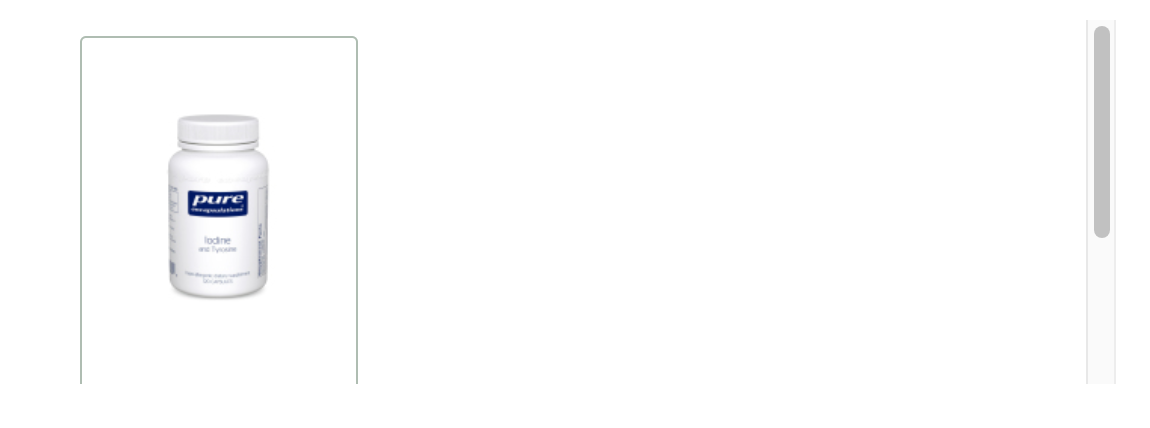Why Your Thyroid Medication May be Failing You
After years of suffering, many women are thrilled to find out that indeed, there is a problem with their #thyroid gland. If blood work reveals elevated TSH and low T4, their doctor will likely prescribe #Synthroid, a synthetic T4 medication.
Let’s break these terms down.

photo via Unsplash by Ulrich Pickert
Thyroid: a small, butterfly-shaped gland in the neck that regulates the body’s metabolic processes.
TSH: Thyroid Stimulating Hormone. This hormone is actually a pituitary hormone. When the hypothalamus senses that the thyroid’s function is impaired, it will tell the #pituitary gland to release more TSH, which tells the thyroid gland to output more thyroid hormone.
T4- the inactive form of thyroid hormone. T4 must convert to the active form of the thyroid hormone, T3 (tri-iodithyronine).
T4 is like premium gas sitting in a gas tank at Chevron. Until someone swipes their credit card and inserts the pump into their car’s fuel tank, the car will not run. There can be hundreds of gallons stored in the gas tank, waiting patiently for its turn to perfectly power a vehicle, but until the transfer of energy has occurred, your car simply will not go anywhere.
Ugh, crap. Since I have no idea about how the engines of cars work, my analogy has to end here. But do you kind of get it?
I want to tell you more about the process of how your thyroid creates #energy. It is important that you understand it.
Thyroglobulin (TG) is a protein that holds #iodine in the thyroid follicles. You need plenty of iodine in your thyroid.
The amino acid tyrosine in necessary to produce thyroglobulin. Iodine and tyrosine mix to form iodotyrosine. So you need plenty of #tyrosine in your thyroid, too.
Thyroid Peroxidase (TPO) iodine is added to tyrosine to make mono-iodotyrosine, or T1.
Then two iodine atoms are tyrosine to make di-iodotyrosine, or T2.
Oooh, this is fun. See how important iodine and tyrosine are?
Then TPO helps T1 and T2 combine to make T3 (the active form of thyroid hormone) and T4 (the inactive form of thyroid hormone- or, iodothyronine). Damn, that’s some complicated stuff.
The TG protein now holds T1, T2, T3, and T4. But they can’t do anything yet. Enzymes need to break down the protein structure to release the “T”s. This happens when TSH tells the thyroid to release them and start the enzymatic process.
T1 and T2 go back into the follicles to make more TG. T4 and T3 are released into the bloodstream.
Ideally, T4 then converts to T3 in the #liver. Some T3 is pushed out into the body.
But the thyroid creates mostly T4. T4 to T3 creation ratio is 17:1. So the body is creating way more inactive thyroid hormone than active thyroid hormone, relying on its own self to convert properly.
It all depends on T3.
Without enough T3, you will be #fat, #constipated, #foggy, and #pissed.
Any hands raised?
It’t not you, darling. It’s your T3.
Well, honestly, it is probably you a little bit too. I speak for myself.
But also. You need enough tyrosine and iodine.
Tyrosine comes from #meat mostly. Iodine comes from seafood mostly.
Do you eat enough of either of these things? Do your #daughters eat enough of these things?

Other sources of tyrosine and iodine:
“Tyrosine, which can also be synthesized in the body from phenylalanine, is found in many high-protein food products such as chicken, turkey, fish, milk, yogurt, cottage cheese, cheese, peanuts, almonds, pumpkin seeds, sesame seeds, soy products, lima beans, avocados, and bananas.
Fish (such as cod and tuna), seaweed, shrimp, and other seafood, which are generally rich in iodine. Dairy products (such as milk, yogurt, and cheese) and products made from grains (like breads and cereals), which are the major sources of iodine in American diets.”
Those quotes are from Wikipedia.
Don’t be fooled. Dairy and gluten are double edged swords. The #dairy and #gluten proteins look very similar to the thyroid #hormone protein, so trying to get iodine from these sources may end up hurting your thyroid health instead of helping it.
Besides, look around you. We eat more breads and cereals and dairy products than ever and clearly, metabolisms have slowed down instead of sped up.
On top of that, heavy gasses like chlorine and bromine (which are found in bread!) displace iodine in the body, and therefore, the thyroid.
Don’t get your iodine from cereal and milk. #Butter is fine, bien sur. Grass fed, please.
Now that you understand what is needed to create healthy thyroid hormones, let’s look at why Synthroid does a crappy job in attempting to “fix” the thyroid.
Synthroid is T4. All levothyroxine is T4. T4, remember, is the inactive form of the thyroid hormone.
It does nothing. It creates no energy. It spikes no metabolism.
Not in and of itself, anyway. It must be converted to T3 first.
And this has to happen in the liver, the gut, the brain, and the thyroid itself.
Most of us have problems with our liver, our gut, our brain, and our thyroid.
This puts a damper on the conversion party, no?
There is another piece of this puzzle.
“During times emotional, psychological or physiological stress, the body will convert excess T4 to reverse T3 (rT3) as a means of conserving energy for healing and repair. It is at least possible, therefore, that replacing thyroid hormone (T4) in these cases may not be beneficial.” -Chris Kresser
The prevalence of emotional, psychological, and physiological stress is quite high right now. Odds are, you or someone you love is feeling as though they suffer from one or more of these stressors.
So most of our bodies are already converting our own T4 to rT3.
RT3 is the inactive form of thyroid hormone, instead of regular T3, which is the active form of the thyroid hormone.
RT3 will block the action of T3 in the cells.
Reverse T3 will make you feel fat, foggy, frustrated, and sleepy.
Giving Synthroid to a person who is already emotionally, psychologically, and physiologically stressed almost ensures that the body will convert all of that T4 into RT3 instead of active T3.
Argh!!!
So you can be on 125 mcg of Synthroid and feel worse than you felt before you went on meds.
In fact, the higher your dose is, the worse you can feel symptomatically because you are blocking more and more active T3.
I know that is a lot to take in, but are you following the line of thought?
Most physicians are trained to treat your lab results. If your TSH is elevated and your T4 is low, you will automatically receive Synthroid.
I look at lab results weekly where the provider has not tested the patient’s T3. Again, this is the active form of thyroid hormone. It is important. Not testing FT3 means we have no idea if any of your thyroid hormone is actually doing anything beneficial in the body.
Nearly 100% of my clients have never had their reverse T3 tested even when they have been on Synthroid for a long period of time.
Symptomatically, they feel the same or worse. And their provider continues to increase their dosage of Synthroid, hoping to alleviate symptoms.
But because very little conversion is happening from T4 to T3,
you
feel
like
crap.
Getting your RT3 tested can help as you will have data to show what is happening with inactive and active thyroid hormone in the body.
Yay! Easy, right?
Not so fast.
About 80% of physicians will not run this test. If TSH looks fine on the lab work and T4 looks fine on the lab work, they see no reason to order another test.
Plus, the RT3 test can be a little pricey (about $200 out of pocket).
But it would behoove you, if you are still feeling terrible, to push for this test. Ask, ask again, and switch providers if you hit a brick wall.
My OB/GYN is pretty amazing and will order any labs I ask her to run on me. She has helped me find my sky high EBV levels and I am so grateful for her open-mindedness. So if my clients tell me their primary or their endo will not run their thyroid labs, I tell them to ask their OB/GYN. There are always options.
A majority of physicians will not even run T3 levels on their patients. They are taught to look at and treat only TSH and T4. (Bangs head against wall).
No. Nyet. Non.
This is the tiniest part of the picture, ladies. You need to know your free T3 and your reverse T3 if you want your thyroid to kick back into gear.
Did you know that the original treatment for hypothyroidism was based on symptoms and not numbers?
Because, honestly, what do you care about?
Numbers? F no!
You care about symptoms.
Three grains, to be exact.
That is a crap ton of NDT. If you happen to work with an open minded provider, he or she may start you on 1/2 grain of NDT. One half grain of NDT works out to 19 mcg T4 and 4.5 mcg T3.
Barnes aimed to get his patients to 27 mcg T3. On top of that, with a proper diet and proper supplements, the body had the opportunity to convert those 57 mcg of T4 into the active T3.
So peoples’ thyroids began to work better. And they felt better.
But there were problems.
Heart rates began to speed up and flutter and become arrythmic. Temperatures increased, diarrhea began, and anxiety and irritability crept in.
So physicians began to back off of this wonder drug. They slipped into the safety and comfort of using numbers to treat people, instead of symptoms to treat people.
Originally and brilliantly, Barnes used individual biofeedback to assess whether or not a patient needed thyroid medication.
Is their body temperature less than 98 degrees?
Is their resting heart rate under 75 BPM?
Are they constipated?
Are they depressed?
Are they cold all of the time?
If the patient answered in the affirmative to most of these questions, they received thyroid medication. And many of them received their life back. That may sound exaggeratory (I made that word up but interestingly, it was not flagged for spell-check), but if you have ever been on the correct dose of thyroid medication after suffering for years, you know what I mean.
And this is how patients were taught to self-titrate their meds.
Because most people know their bodies. And most people are not idiots. If you are anxious and experiencing Disaster Pants, you know intuitively to decrease your thyroid meds before you experience heart problems, yes?
It is not that doctors don’t believe this, but there are serious side effects from too much T3, and doctors want to protect their patients and also their malpractice insurance rates.
Thank you, government, for making it harder for we the people to have access to correct thyroid medication by scaring our physicians, who take an oath to first do no harm, into passivity due to the threat of malpractice suits.
I hope it makes you as mad as it makes me.
It probably doesn’t. That’s ok. I will be mad for you.
Really, a full-spectrum thyroid medication is better for many hypothyroid sufferers than T4 alone. Some people do fine on T4, but I rarely see those people.
For a select group of people who have failed both T4 and NDT, T3 monotherapy may be a viable option.
After studying this modality intensively, I see the benefits of T3 monotherapy for a select population. However, this is a riskier therapy (at least, in the eyes of the medical establishment), and a whole host of factors must be conscientously addressed before attempting monotherapy.
These include
healing the adrenals (testing morning cortisol and 24 hour free cortisol levels)
optimizing B12
sealing and healing the gut
reversing anemia
being clear of heart trouble
One doctor out of 1000 may be open to allowing you to try T3 monotherapy, especially at the doses necessary for results to be seen (10-50 mcg, sometimes more), but as an educator, provider, and women’s health advocate, I want to make you aware of the options that may be available to you.
Clearly, our current standard of thyroid care is not working. Even in the 1950’s, Broda Barnes hypothesized, based on his clinical findings, that close to 40% of the American public suffered from hypothyroidism.
40%.
In 1950.
That number could be twice that in our era of processed food, environmental endocrine disruptors, sky-high stress levels, and inactivity.
Further, “Barnes believed that many common diseases, including heart disease, cancer, depression, arthritis, diabetes, the common cold, tonsillitis, ear infections, apparent laziness in children, various menstrual disorders, and skin disorders, were all caused or exacerbated by hypothyroidism”.
Does this sound like you or anyone you know?
Ok, that was a lot. Let’s get practical.
-
- Get your thyroid tested. Test for T4, T3, and TPO antibodies at least. TSH is fine, though it does not mean much. Get RT3 tested if you have been on Synthroid for a long time and don’t feel any better.
- If you have no access to these tests, get ahold of me so I can point you in the right direction.
- Start tracking your basal body temperature and your resting heart rate.
- Optimize your levels of tyrosine and iodine.
- Ask your doctor for a trial of NDT. Alternatively, ask for Cytomel of T3 to be added to your thyroid medication regimen.
- Take this list of studies to your physician to help him or her think through the decision to switch your thyroid meds. Make sure you read through these studies yourself so you know what you are talking about, and what you are asking for.
- Ask your doctor for a trial of NDT. Alternatively, ask for Cytomel of T3 to be added to your thyroid medication regimen.
- Optimize your levels of tyrosine and iodine.
- Start tracking your basal body temperature and your resting heart rate.
- If you have no access to these tests, get ahold of me so I can point you in the right direction.
- Get your thyroid tested. Test for T4, T3, and TPO antibodies at least. TSH is fine, though it does not mean much. Get RT3 tested if you have been on Synthroid for a long time and don’t feel any better.
https://www.ncbi.nlm.nih.gov/pmc/articles/PMC5965938/ (Long term T4 + T3 improving quality of life)
https://academic.oup.com/jcem/article/97/7/2256/2833962 (T4 + T3 and personalized therapy)
https://www.ncbi.nlm.nih.gov/pubmed/16483669/ (How T3 therapy helps treatment-resistant depression)
https://www.ncbi.nlm.nih.gov/pmc/articles/PMC5869352/ (T3 therapy for Chronic Fatigue Syndrome)
These peer-reviewed study links were part of a program I paid for, provided by Dr. Westin Childs. His patient-education website is unparalleled in quality and information, and I urge you to study it if you are suffering from thyroid problems.
I hope and pray this article is helpful for many of you. Please send it along to anyone who would benefit from it. I agree with Dr. Barnes that the number of hypothyroid sufferers is closer to 40%, if not much higher than that in this era. Be an informed advocate for your own health.
Nourish yourself so you can nourish others.
To your thyroid health,
Jennifer






